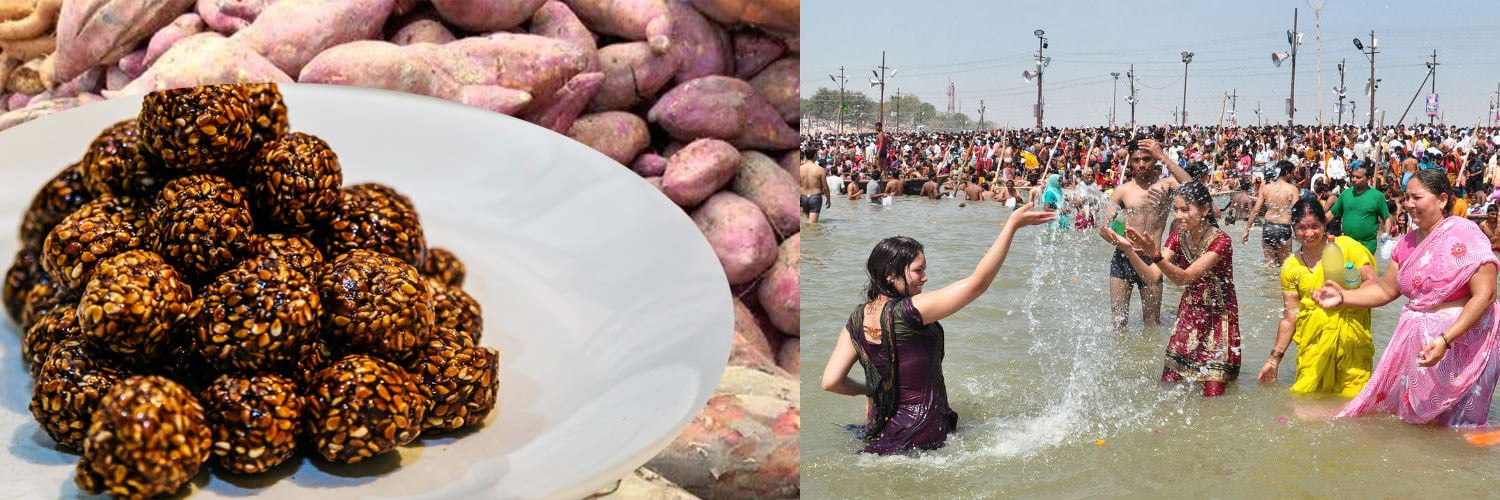One of the most important celebrations in the month of Magh is Maghe Sankranti (According to BikramSambat calendar or about middle of January). Makar Sankranti is another name for the celebration. It marks the beginning of the fortunate month of Magh in Nepal. In comparison to the chilly month of Poush, the celebration is seen as the start of warmer days (December). It is thought that the sun will begin to travel toward the northern hemisphere on this day. In Nepal, a solstice celebration is observed.
During this occasion, Hindu devotees bathe in Nepal’s auspicious and religious rivers. Shankamul on the Bagmati River, Gandaki/Narayani River in the Triveni, Devghat in Chitwan, Ridi on the Kaligandaki, and Dolalghat on the Sunkoshi in the Koshi River basin are some of Nepal’s significant holy river sites. People pray to Vishnu, have Pujas, and read the Hindu sacred Bhagwad Gita.
In the first of Magh, families gather together and share food. During this joyful occasion, they enjoy TilLaddoo, Ghee, and Sweet Potatoes. The priest wishes everyone in the family good health and a brighter future. The Nepalese Brahmins and Chhetris celebrate Magh by inviting their married daughters and close relatives to their homes and providing them with special feasts and gifts and best wishes.This event is extremely important to Nepal’s distinct ethnic community, the Tharu community. The first of Magh is known as “Maaghi.” The first of Magh is also the start of the Tharu New Year. Maaghi is also the Tharus and Terai people’s harvest festival. Maaghi is seen as a happy moment after a long day of fieldwork.They prepare a variety of foods, beverages, and meats and assemble their family and community to celebrate. Tharus celebrates the Maaghi for a week. They conduct cultural dances, dress up in traditional Tharu attire, and eat and drink with their loved ones throughout the celebration.
MakarSankranti is also celebrated with great enthusiasm by the Magar community. They invite their married daughters to celebrate and even worship with them at home. On this important day, various delicacies including sweet potatoes are consumed.A bullfighting event is held in Nuwakot during the month of Magh. In Nuwakot, tamed bulls are readied for fighting, and a large crowd gathers to see the traditional event of this region. No one is involved in the groundwork for this festival. It’s just a bull and a bullfight. Provocation outside of the field, on the other hand, can be noticed.
The MagheSankranti holiday is widely observed throughout the country. In Hindu epics such as the Mahabharata, the significance of this day is also described. People nowadays worship the Sun deity, who is considered as a sign of divinity and knowledge. In Nepal, this event has significant religious and historical importance.MakarSankranti is greatly venerated in various regions of Nepal, namely the plains, as the “holy period of transition” accompanied with some cultural and religious values. Maghi, Tharus’ most important celebration, happens on the same day. It is also regarded as harvest time, when Tharu people complete all fieldwork and return to their usual lives, celebrating their hard work and reveling in the festivities.
It also represents the start of the fortunate season when the bitter winter is brought down and the warmer days begin. MagheSankranti festival is celebrated in Nepal’s mountainous area with delicacies and fun, as well as dances and culture. Also, Tharus and Madhesi tribes in the Terai area celebrate it as a harvest festival.On the festival of MagheSankranti, worshippers congregate around sacred rivers and bathe in them. To share the delight and gladness, feasts with unique foods such as yam, khichadi, butter, and chaku are served. GheuChakuSallhu is how the Newar community in Kathmandu Valley celebrates MakarSankranti. The mouthwatering dishes add to the fun and awe-inspiring festivity.
The significance of MagheSankranti is essentially the building of family and community bonds. In Nepal, the happy celebration on this specific day is greatly revered. According to Hindu tradition, several holy books also mention the significance of MagheSankranti.According to the epic Mahabharata, BhismaPitamaha, who possesses enormous strength and has received the benefits of being able to control his own death, decided to die on this day. People who die on this day are said to achieve Moksha, or freedom from the cycle of birth and reincarnation. Huge religious qualities among many ethnic tribes commemorate MagheSankranti in their own unique ways.The delicacies range from one community to the next. This also includes Nepalese cultural characteristics such as family ties and joyful celebrations.
-Article written by: Saru Niraula for Land Nepal

